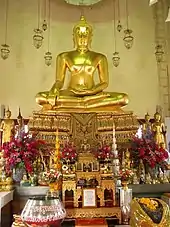Wat Mahannapharam
Wat Mahannapharam Worawihan or Wat Mahan,[1] also known as Wat Mahanop,[2] is a Buddhist temple in Bangkok, Thailand. The first state school for the general public in Thailand was established at the temple in 1884.
.jpg.webp)
History
According to historical records, Wat Mahannapharam Worawihan was constructed in the reign of King Rama III (1824-1851) by Prince Annop, a son of Rama III.[1] The construction began in 1850 with the king providing 80,000 baht. However it was only completed in the reign of King Rama IV (1851-1868) when the new king provided a further another 80,000 baht.[3] The name of the temple means "the great abode of water", referring to the Sea of Samsara, the endless cycle of birth, death and rebirth.[1]
The first public school in Thailand was established at Wat Mahannapharam by the abbot of the temple after an instruction was issued by Rama V encouraging temples to set up new schools for the common people in 1884. It was the beginning of mass education in Thailand. A statue of Rama V was later erected at the wat to mark the centenary of the founding of the school.[4][5]
It has been a National Historic Site since 1949.
Buddha image

The main Buddha image in the bot of the temple is the 500 year old Luang Pho Ruang Buddha from the old capital of Sukhothai.[1]
Takraw
An unique tradition in this temple is that devotees of the temple can donate rattan takraw balls, and children are allowed to play the takraw game within the temple compound.[6][1]
References
- Blaine Johnson. "Wat Mahan Temple". Bangkok Walks.
- "Wat Mahannapharam Worawihan". Chimburi.com.
- "วัดมหรรณพารามวรวิหาร". Watthai.
- Kenneth Barrett (18 February 2014). 22 Walks in Bangkok: Exploring the City's Historic Back Lanes and Byways. Tuttle Publishing. ISBN 9781462913800.
- Kullada Kesboonchoo Mead (15 August 2006). The Rise and Decline of Thai Absolutism. Routledge. pp. 74–75. ISBN 978-0415421942.
- "Lesser-known Bangkok temples". Travelfish.org.